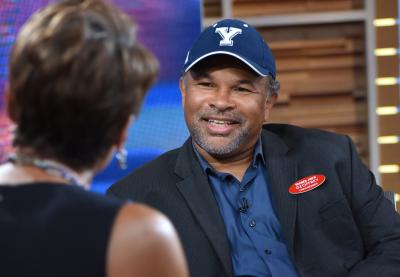When actor Geoffrey Owens, best known for his role on The Cosby Show, woke up one Friday morning, he could not have imagined he’d be back in the spotlight by the end of the day.
But after a few news outlets, namely Daily Mail and Fox News, posted a candid photo of the actor working a register at a Trader Joe’s, he was “devastated.” It’s not because Owens was ashamed of his job. He’d worked at the grocery store for 15 months, in part because it provided him with the flexibility to continue working as an actor.
More articles followed, and the tone of these pieces—which included phrases like “dirty uniform” and “stain marks”—attempted to humiliate Owens. One even pointed out that he played a doctor in his most famous role, the author inviting readers to draw a comparison between Owens' admirable, fictional occupation and his real-life work at a grocery store.
Then something amazing happened. Fans and fellow actors lit up the internet, calling out the “job shaming.” Owens, proudly sporting his Trader Joe’s name tag, was invited to shows like Good Morning America to talk about his renewed fame. His message was clear: “There is no job that’s better than another job. It might pay better, it might have better benefits, it might look better on a resume and on paper. But actually, it’s not better. Every job is worthwhile and valuable.”
And all people should be treated with dignity and respect, regardless of their occupation. Period.
Owens explained that, while his time in the news cycle is sure to pass soon, he hopes it serves as a teachable moment, one that prompts us to reexamine what we truly value in this country.
“I hope what doesn’t pass is this idea that people are now thinking—this rethinking—about what it means to work, the honor of the working person and the dignity of work,” he said.
When you talk to your students about work, what are the values that you promote? Teaching Tolerance has a wealth of resources that can help you consider your own practice and engage your students in conversations about the dignity of all work. Here are a few places to start.
Instead of equating certain types of work with success or binding our identity too closely to our occupations, let’s encourage all students to see the dignity in all work.
You can begin by revisiting your own practices and considering how you speak with your students about labor and class. In our article “Five Questions for Stephanie Jones,” you’ll find recommendations for class-sensitive pedagogy. And “Rethinking Poverty and Casual Conversations” can help you consider the ways that unintentional classism can seep into small talk with students. In “School Is No Place for Class(ism),” you’ll find examples of—and alternatives to—the classist language often heard in school spaces when educators push students to work hard by threatening a minimum-wage future.
But addressing our own practices may not be enough; we also need to encourage students to recognize and critique the classist ideas they encounter outside of school. Instead of encouraging students to look down on certain jobs, it’s better that we teach them to understand how the systems that lock people into those jobs work to create and sustain inequality and poverty.
Young people are already bombarded with messages that shame people who perform physical labor or who don’t earn a lot of money. Our lesson “Looking at Labor” helps students find the flaws in these messages. You can provide students with more valuable context about the longstanding relationships among labor, activism and social justice with one of our many articles, texts and lessons on the labor movement (find them all by searching “labor”).
Finally, we can challenge ourselves to think about the messages we send to students about what it means—and what it takes—to be successful. “Question the American Dream" and “Reflecting on the American Dream” are great starting points. Popular culture continues to celebrate the journey from “the bottom to the top,” and Drake’s not too far removed from Horatio Alger: We’ve always loved a good rags-to-riches story.
But we have to be careful of the ways we tell these stories. When we insist to students that anyone can “make it” if they’re smart enough, if they’re hardworking enough, then we’re also telling them the opposite—that those who don’t “make it” are lacking in some way. When we say that, we’re sending a clear and dangerous message: that poverty is evidence of moral failure.
When we think carefully about the messages we send—both overtly and implicitly—to our students, we’re not only putting anti-bias education into practice; we’re also modeling a critical engagement with the world that surrounds us. Instead of equating certain types of work with success or binding our identity too closely to our occupations, let’s encourage all students to see the dignity in all work. Let’s teach them to value and celebrate the dignity in all people, independent from how they earn a wage.
Dillard is a staff writer for Teaching Tolerance.
